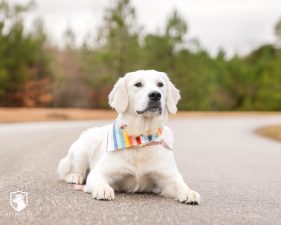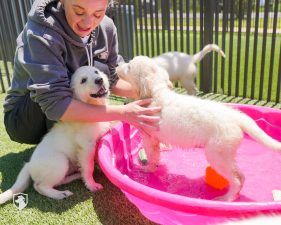How To Handle The Fear Period In A Puppy
The Fear Period is a unique point in the life of a puppy. It usually appears suddenly, and attempting to resolve fear issues during this stage of puppyhood can leave even seasoned dog owners perplexed. However, don’t worry! It won’t last forever, and usually, it is rather simple to correct with a bit of patience and knowledge of how to respond to your puppy’s fear.
In this article, we will equip you with the tools you need to be prepared to respond correctly to your pup if and when you encounter a Fear Period.
What Is a Fear Period In a Puppy?
 First of all, let’s answer the question, “What is a Fear Period?” It is simply a phase of puppyhood that arises between 8 and 10 months of age. During this phase, some puppies, out of nowhere, begin to convey an irrational fear of harmless objects or places they previously showed no fear towards. This fear can manifest itself in various ways, such as barking, trembling, backing away from an object, or refusing to continue walking towards it.
First of all, let’s answer the question, “What is a Fear Period?” It is simply a phase of puppyhood that arises between 8 and 10 months of age. During this phase, some puppies, out of nowhere, begin to convey an irrational fear of harmless objects or places they previously showed no fear towards. This fear can manifest itself in various ways, such as barking, trembling, backing away from an object, or refusing to continue walking towards it.
Please understand that if your puppy encounters a fear period, it isn’t your fault. No breed is perfect, and the Fear Period is simply one of the few “flaws” to which English Cream Golden Retrievers are susceptible. The correct way to handle a fear period is quite counter-intuitive. So please take the time to read the tips below carefully to be well prepared to lead and guide your pup through their fears if and when their Fear Period occurs.
The Most Common Mistake When Dealing With A Fear Period
As humans who need love and comfort, our first reaction when we see our beloved canine family members struggling with fear is to find a way to comfort them. Ironically, this is the worst recourse a dog owner could take. When a pup shows a non-warranted fearful reaction, by coddling the dog, the owner unknowingly condones and reinforces this behavior.
A good analogy would be obedience training. In obedience training, when we want a dog to know that they did the correct thing in response to our command, we shower them with positivity using a high-pitched voice, giving them loving pets, etc. This lets the pup know that they did the correct thing, and they receive love and affection from their human for repeating the action. Similarly, if we touch the pup or attempt to comfort them using our voices when they are showing unjustified fear, we inadvertently send a strong signal to the pup that says, “Good job! Keep doing what you’re doing!” Ironically, this is the last thing we want to convey in these situations.
How To Properly Deal With a Fear Period
If we must learn to resist the strong temptation to rush in and “save” our pups from can-crushing noises or other irrational fears they demonstrate during a fear period, what should we do instead? The best thing you can do when you encounter your pup struggling with a fear period is not to react at all to the cause of the fear. If a pup is scared to leave its crate, ignore her. She will eventually have to exit on her own. If he is petrified of the sounds of thunder, continue doing whatever you would normally do, making the same sounds and displaying the same calm, positive energy you would have otherwise.
Simply acknowledging the “scary” object will inevitably increase the nervous sensation in the pup’s mind. However, if we remain calm and nonchalant towards the stimulus, our pup will eventually realize that they also do not need to fear. Your pup has learned to trust you and be confident in who you are, and ultimately wants to know that they are protected by you. If they see through our calm energy that we have nothing to fear, then they will eventually mimic that behavior and realize that they also have nothing to fear.
 I say “eventually” because it will not be an immediate epiphany for the dog and might even take days or weeks. This is where patience comes in on the part of the owner. It will require quite a few instances of completely ignoring your pup’s fear for the realization to begin to sink in for the pup. The good news, however, is that the more times you exemplify the correct behavior for your pup, the more the pup will begin to apply their newly learned confidence to all new objects in general. The purpose isn’t necessarily to teach the pup that specific objects are harmless, but to teach the pup that new objects are to be investigated with caution and curiosity, not panic and anxiety.
I say “eventually” because it will not be an immediate epiphany for the dog and might even take days or weeks. This is where patience comes in on the part of the owner. It will require quite a few instances of completely ignoring your pup’s fear for the realization to begin to sink in for the pup. The good news, however, is that the more times you exemplify the correct behavior for your pup, the more the pup will begin to apply their newly learned confidence to all new objects in general. The purpose isn’t necessarily to teach the pup that specific objects are harmless, but to teach the pup that new objects are to be investigated with caution and curiosity, not panic and anxiety.
What to do if you’re in a public place where you can’t simply ignore your dog and walk away, but instead are forced to confront the situation directly? For example, if your dog suddenly begins to display an unwarranted fear of the vet’s office, which you have visited many times with no issues? The key here is still to maintain a passive role instead of actively trying to fix the problem.
Simply existing and being near your dog is all they need in these situations. In this specific example, the best thing to do would be to sit in the waiting room and keep your pup on leash, have them sit by your feet, and allow them to lean against you or make contact with you. Don’t allow your pup to paw at you or get in your lap. The contact of leaning against you helps reassure your pup but will not encourage their behavior. However you feel about a situation is how your dog will feel about it. The first few times you put this technique into practice, you may have to simply “ride out” the tantrum or fear. However, with repeated instances of you being nonchalant and going on with your life as normal, including when dealing with situations that may trigger anxiety in dogs, the pup should learn to trust your calm demeanor enough to relinquish their temptation towards anxiety and fear.
Keep a Positive Attitude Around Your Puppy’s Fear
 Lastly, having a positive attitude helps. If you enter into a particular situation that is scary for your dog with a cynical attitude, they will pick up on this nervous energy, thus resulting in the same reaction as before. However, if you enter into that same situation with an attitude of wonder about what kind of new and improved reaction you might get this time, you’ll be surprised at how much quicker your dog will catch on to your excitement and curiosity, and follow suit.
Lastly, having a positive attitude helps. If you enter into a particular situation that is scary for your dog with a cynical attitude, they will pick up on this nervous energy, thus resulting in the same reaction as before. However, if you enter into that same situation with an attitude of wonder about what kind of new and improved reaction you might get this time, you’ll be surprised at how much quicker your dog will catch on to your excitement and curiosity, and follow suit.

